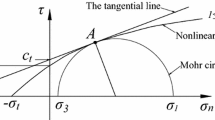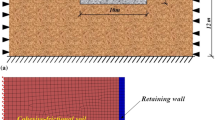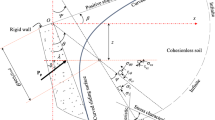Abstract
Lateral earth pressure on retaining walls is a widely researched classical problem in geotechnical engineering. This study investigates the active lateral earth pressure on a circular retaining wall using the stress characteristics method in the presence of soil-wall adhesion and friction. A computer code was developed for determining the lateral pressure of soil on the wall as well as the lateral pressure coefficients upon receiving the required input parameters. The principle of superposition was implemented to determine the lateral earth pressure coefficients. The effects of the soil-wall adhesion and friction angle on the lateral earth pressure were studied under active conditions. Moreover, the effects of these parameters on the characteristics network and failure region were demonstrated. The results showed that the coefficient of lateral earth pressure due to cohesion increased with increasing adhesion at the soil-wall boundary.














Similar content being viewed by others
Abbreviations
- c :
-
Soil cohesion
- H :
-
Retaining wall height
- k aγ :
-
Active earth pressure coefficients due to weight
- k aq :
-
Active earth pressure coefficients due to surcharge
- k ac :
-
Active earth pressure coefficients due to soil cohesion
- p a :
-
Active lateral earth force
- q :
-
Uniform surcharge
- r :
-
Horizontal or radial coordinate
- r 0 :
-
Distance from the wall to the axis of symmetry
- s :
-
Mean stress, (σ r + σ z )/2
- s 0 :
-
Mean stress on the ground surface
- s f :
-
Mean stress on the wall boundary
- z :
-
Vertical coordinate
- β :
-
Ground surface angle
- ϕ :
-
Soil internal friction angle
- γ :
-
Soil unit weight
- θ :
-
Wall inclination angle with vertical
- σ 0 :
-
Normal stress at the ground boundary
- σ f :
-
Normal active lateral stress along the soil-wall interface
- σ θ :
-
Tangential stress
- σ r :
-
Normal stress in r-direction
- σ z :
-
Normal stress in z-direction
- τ 0 :
-
Shear stress at the ground boundary
- τ rz :
-
Shear stress
- ψ :
-
Angle between major principal stress direction and r-axis
- ψ 0 :
-
The angle ψ on the ground surface
- ψ f :
-
The angle ψ on the wall boundary
References
Motta E (1994) Generalized coulomb active-earth pressure for distanced surcharge. J Geotech Eng 120(6):1072–1079
Chen Z, Li S (1998) Evaluation of active earth pressure by the generalized method of slices. Can Geotech J 35(4):591–599
Hajiazizi M, Mazaheri AR (2015) Use of line segment slip surface for optimized design of piles in stabilization of the earth slopes. Int J Civil Eng 13(1):14–27
Handy RL (1985) The arch in soil arching. J Geotech Eng 111(3):302–318
Tafreshi SN, Nouri TA (2014) A simplified pseudo-static seismic analysis of reinforced soil walls with uniform surcharge. Int J Civil Eng 12(2):97–109
Vieira CS (2014) A simplified approach to estimate the resultant force for the equilibrium of unstable slopes. Int J Civil Eng 12(1):65–71
Wang Y (2000) Distribution of earth pressure on a retaining wall. Geotechnique 50(1):83–88
Sokolovskii VV (1960) Statics of soil media. Butterworths Scientific, London, England
Veiskarami M, Kumar J, Valikhah F (2014) Effect of the flow rule on the bearing capacity of strip foundations on sand by the upper-bound limit analysis and slip lines. Int J Geomech 14(3):04014008
Jahanandish M, Keshavarz A (2005) Seismic bearing capacity of foundations on reinforced soil slopes. Geotext Geomembr 23(1):1–25
Keshavarz A, Jahanandish M, Ghahramani A (2011) Seismic bearing capacity analysis of reinforced soils by the method of stress characteristics. Iran J Sci Technol Trans Civil Eng 35(C2):185–197
Vo T, Russell AR (2014) Slip line theory applied to a retaining wall–unsaturated soil interaction problem. Comput Geotech 55:416–428
Keshavarz A, Fazeli A, Sedeghi S (2016) Seismic bearing capacity of strip footings on rock masses using the hoek-brown failure criterion. J Rock Mech Geotech Eng 8:170–177
Veiskarami M, Zanj A (2014) Stability of sheet-pile walls subjected to seepage flow by slip lines and finite elements. Geotechnique 64(10):759–775
Berezantzev V (1952) Axially symmetrical limit equilibrium problems of loose materials (soil)[m]. Gostekhizdat Brinch Hansen, Moscow
Habibagahi K, Ghahramani A (1979) Zero extension line theory of earth pressure. J Geotech Eng Div 105(7):881–896
Ghahramani A, Clemence SP (1980) Zero-extension line theory of dynamic passive pressure. J Geotech Eng Div 106(6):631–644
Keshavarz A, Pooresmaeil Z (2016) Evaluation of the static and seismic active lateral earth pressure for c-ϕ soils by the zel method. Scientia Iranica 23(1):142–154
Liu F, Wang J, Zhang L (2009) Axi-symmetric active earth pressure obtained by the slip line method with a general tangential stress coefficient. Comput Geotech 36(1):352–358
Liu F, Wang J (2008) A generalized slip line solution to the active earth pressure on circular retaining walls. Comput Geotech 35(2):155–164
Peng MX, Chen J (2013) Slip-line solution to active earth pressure on retaining walls. Geotechnique 63(12):1008–1019
Cheng Y, Hu Y, Wei W (2007) General axisymmetric active earth pressure by method of characteristics—theory and numerical formulation. Int J Geomech 7(1):1–15
Jahanandish M (2003) Development of a zero extension line method for axially symmetric problems in soil mechanics. Scientia Iranica 10(2):203–210
Liu F, Wang J, Zhang L (2009) Analytical solution of general axisymmetric active earth pressure. Int J Numer Anal Meth Geomech 33(4):551–565
Liu F (2014) Lateral earth pressures acting on circular retaining walls. Int J Geomech 14(3):04014002
Keshavarz A (2016) Evaluation of the plastic critical depth in seismic active lateral earth pressure problems using the stress characteristics method. Acta Geotechnica Slovenica 13(1):19–27
Lee I, Herington J (1972) A theoretical study of the pressures acting on a rigid wall by a sloping earth or rock fill. Geotechnique 22(1):1–26
Author information
Authors and Affiliations
Corresponding author
Rights and permissions
About this article
Cite this article
Keshavarz, A., Ebrahimi, M. The Effects of the Soil-Wall Adhesion and Friction Angle on the Active Lateral Earth Pressure of Circular Retaining Walls. Int. J. Civ. Eng. 14, 97–105 (2016). https://doi.org/10.1007/s40999-016-0016-3
Received:
Revised:
Accepted:
Published:
Issue Date:
DOI: https://doi.org/10.1007/s40999-016-0016-3




